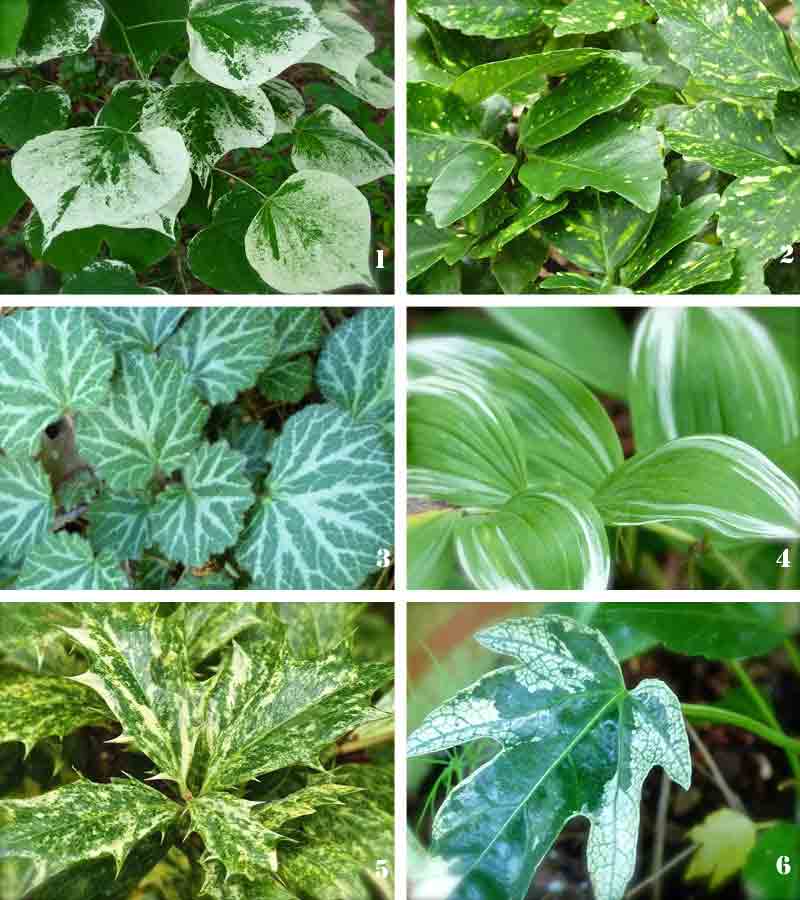Create Drama with Variegated Foliage
 Saturday, August 8, 2015 at 8:45PM
Saturday, August 8, 2015 at 8:45PM For drama in the garden, or maybe just for fun, plant something with variegated foliage. I confess I am immediately drawn to any sort of multi-colored foliage, and my garden shows it. Stripes, splotches and spots create interest where flowers are fleeting in my predominantly shady landscape, and a plant with variegation can light up the darkest corner.
Variegation appears as differently colored areas on leaves or stems, often white or gold, but sometimes pink or purple. Some plants have a variety of shades on the same leaf and can rival any flower for color. These types of plants make good focal points, but too many close together can clash or appear jarring. Many variegated plants look good with solid companions or those whose flowers or leaves match the variegated plant's color markings. The white edging of variegated Japanese pittosporum matches the white flowers of native Eurybia divaricata (White wood aster). Note how the aster's radiant form also repeats the form of the pittosporum.One can also combine variegated plants in a small grouping by repeating the variegated color of one plant in different degree or form in another variegated plant.
The white edging of variegated Japanese pittosporum matches the white flowers of native Eurybia divaricata (White wood aster). Note how the aster's radiant form also repeats the form of the pittosporum.One can also combine variegated plants in a small grouping by repeating the variegated color of one plant in different degree or form in another variegated plant.
 The white edging of Variegated Plectranthus is repeated in large splashes on the leaves of Stromanthe tricolor.
The white edging of Variegated Plectranthus is repeated in large splashes on the leaves of Stromanthe tricolor.
These oddities may make a plant desirable to plant collectors, but not everyone likes these types of plants. What about you? The following is a sampling of the variegated plants in my garden; certainly not all of them! Most are hardy in my USDA hardiness zone 7b/8a landscape.  1. Heuchera 'Tiramisu' 2. Hosta 'Francis Williams' 3. Zantedeschia albomaculata 4. Calla lily 'Tropicana' 5. Variegated ivy 6. Nandina 'Firepower'
1. Heuchera 'Tiramisu' 2. Hosta 'Francis Williams' 3. Zantedeschia albomaculata 4. Calla lily 'Tropicana' 5. Variegated ivy 6. Nandina 'Firepower'
 1. Fatshedera 'Angyo Star' 2. Round-lobed Hepatica 3. Persicaria 'Red Dragon' 4. Variegated Pittosporum 5. Acer palmatum 'Butterfly' 6. Hydrangea macrophylla 'Variegata'
1. Fatshedera 'Angyo Star' 2. Round-lobed Hepatica 3. Persicaria 'Red Dragon' 4. Variegated Pittosporum 5. Acer palmatum 'Butterfly' 6. Hydrangea macrophylla 'Variegata'
 1. Hosta 'June' 2. Cornus florida 'Cherokee Sunset' 3. Trillium cuneatum (Sweet Betsy) 4. Japanese Painted Fern 5. Variegated Winter daphne 6. Heuchera 'Green Spice'
1. Hosta 'June' 2. Cornus florida 'Cherokee Sunset' 3. Trillium cuneatum (Sweet Betsy) 4. Japanese Painted Fern 5. Variegated Winter daphne 6. Heuchera 'Green Spice'
 1. Heucherella 'Alabama Sunset' 2. Houttuynia 3. Stromanthe 'tricolor' (not hardy) 4. Carex oshimensis 'Evergold' 5. Persian shield (not hardy) 6. Ficus variegata (not hardy)
1. Heucherella 'Alabama Sunset' 2. Houttuynia 3. Stromanthe 'tricolor' (not hardy) 4. Carex oshimensis 'Evergold' 5. Persian shield (not hardy) 6. Ficus variegata (not hardy)
 1. Cercis canadensis 'Whitewater' 2. Variegated acuba 3. Saxifraga stolonifera (Strawberry begonia) 4. Tricyrtis hirta 'variegata' (toad lily) 5. Osmanthus heterophyllus 'Goshiki' 6. Fatsia japonica 'Spider's Web'
1. Cercis canadensis 'Whitewater' 2. Variegated acuba 3. Saxifraga stolonifera (Strawberry begonia) 4. Tricyrtis hirta 'variegata' (toad lily) 5. Osmanthus heterophyllus 'Goshiki' 6. Fatsia japonica 'Spider's Web'
What do you think about variegated foliage? Are there some that you love? Make you cringe? My opinion is there must be at least one for everyone. Or in my case, at least thirty!
Have a great week! Deb
 plant combinations,
plant combinations,  variegated foliage in
variegated foliage in  foliage
foliage 


